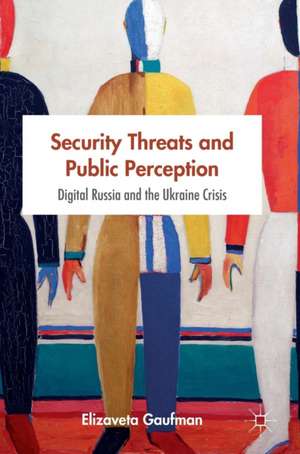Security Threats and Public Perception: Digital Russia and the Ukraine Crisis: New Security Challenges
Autor Elizaveta Gaufmanen Limba Engleză Hardback – 4 noi 2016
The author examines how enemy images are manufactured, threats magnified, stereotypes revived, memories implanted and fears harnessed. It looks at the legacy of the Soviet Union in shaping discussions ranging from the Ukraine crisis to the Pussy Riots trial, and explores the complex inter-relation between enemy images at the governmental level and their articulation by the general public. By drawing on the fields of international relations, memory studies, visual studies, and big data, this book addresses the question of why securitization succeeds – and why it fails.
"Security theory meets the visual turn and goes to Russia, where old tsarist and Soviet tropes are flooding the internet in support of Putin's neo-tsarism. A magical mystery tour that comes recommended.
Iver B. Neumann, author of "Russia and the Idea of Europe"
“The novelty of her approach is in going beyond the traditional top down perspective and capturing the receptivity and contribution of various social groups to securitized discourses.”
Andrei P.Tsygankov, author of "Russia's Foreign Policy: Change and Continuity in National Identity".
“When do scary proclamations of security threats attract an audience? When does securitization work? ‘Security Threats and Public Perception’ combines in-depth analysis of the Ukraine Crisis in the Russian digital media with discourse theory to make an innovative argument about how and when people believe that they are insecure. A must read!”
Laura Sjoberg, AssistantProfessor of Political Science, University of Florida, USA
| Toate formatele și edițiile | Preț | Express |
|---|---|---|
| Paperback (1) | 776.57 lei 6-8 săpt. | |
| Springer International Publishing – 27 iun 2018 | 776.57 lei 6-8 săpt. | |
| Hardback (1) | 781.15 lei 6-8 săpt. | |
| Springer International Publishing – 4 noi 2016 | 781.15 lei 6-8 săpt. |
Din seria New Security Challenges
- 15%
 Preț: 636.94 lei
Preț: 636.94 lei - 15%
 Preț: 580.68 lei
Preț: 580.68 lei -
 Preț: 390.63 lei
Preț: 390.63 lei -
 Preț: 381.59 lei
Preț: 381.59 lei -
 Preț: 428.07 lei
Preț: 428.07 lei - 15%
 Preț: 644.95 lei
Preț: 644.95 lei -
 Preț: 386.61 lei
Preț: 386.61 lei -
 Preț: 391.61 lei
Preț: 391.61 lei -
 Preț: 389.88 lei
Preț: 389.88 lei -
 Preț: 385.84 lei
Preț: 385.84 lei - 15%
 Preț: 649.06 lei
Preț: 649.06 lei - 15%
 Preț: 699.77 lei
Preț: 699.77 lei -
 Preț: 383.93 lei
Preț: 383.93 lei -
 Preț: 390.63 lei
Preț: 390.63 lei -
 Preț: 388.13 lei
Preț: 388.13 lei -
 Preț: 382.18 lei
Preț: 382.18 lei -
 Preț: 392.60 lei
Preț: 392.60 lei -
 Preț: 388.72 lei
Preț: 388.72 lei -
 Preț: 387.38 lei
Preț: 387.38 lei - 15%
 Preț: 695.70 lei
Preț: 695.70 lei - 15%
 Preț: 584.43 lei
Preț: 584.43 lei -
 Preț: 383.93 lei
Preț: 383.93 lei -
 Preț: 388.52 lei
Preț: 388.52 lei -
 Preț: 384.86 lei
Preț: 384.86 lei - 18%
 Preț: 726.37 lei
Preț: 726.37 lei - 15%
 Preț: 697.97 lei
Preț: 697.97 lei -
 Preț: 384.09 lei
Preț: 384.09 lei -
 Preț: 388.13 lei
Preț: 388.13 lei -
 Preț: 385.47 lei
Preț: 385.47 lei - 15%
 Preț: 640.88 lei
Preț: 640.88 lei -
 Preț: 385.84 lei
Preț: 385.84 lei -
 Preț: 383.93 lei
Preț: 383.93 lei -
 Preț: 382.75 lei
Preț: 382.75 lei -
 Preț: 389.70 lei
Preț: 389.70 lei -
 Preț: 382.95 lei
Preț: 382.95 lei -
 Preț: 387.38 lei
Preț: 387.38 lei -
 Preț: 386.81 lei
Preț: 386.81 lei
Preț: 781.15 lei
Preț vechi: 952.61 lei
-18% Nou
Puncte Express: 1172
Preț estimativ în valută:
149.47€ • 156.06$ • 123.71£
149.47€ • 156.06$ • 123.71£
Carte tipărită la comandă
Livrare economică 04-18 aprilie
Preluare comenzi: 021 569.72.76
Specificații
ISBN-13: 9783319432007
ISBN-10: 3319432001
Pagini: 239
Ilustrații: XI, 222 p. 22 illus. in color.
Dimensiuni: 148 x 210 x 18 mm
Greutate: 0.42 kg
Ediția:1st ed. 2017
Editura: Springer International Publishing
Colecția Palgrave Macmillan
Seria New Security Challenges
Locul publicării:Cham, Switzerland
ISBN-10: 3319432001
Pagini: 239
Ilustrații: XI, 222 p. 22 illus. in color.
Dimensiuni: 148 x 210 x 18 mm
Greutate: 0.42 kg
Ediția:1st ed. 2017
Editura: Springer International Publishing
Colecția Palgrave Macmillan
Seria New Security Challenges
Locul publicării:Cham, Switzerland
Cuprins
Chapter 1. Introduction.- Chapter 2. Defining Securitization, Enemy Image Research, and Memory Studies.- Chapter 3. Identifying Threat Narratives.- Chapter 4. Back to the USSR: The United States of America as the Primary Threat to Russia.- Chapter 5. World War II 2.0: Narrative of Fascism and the Ukraine Crisis.- Chapter 6. Blasphemy: Threats to Russia’s ‘Spiritual Bonds’.- Chapter 7. ‘Sexuality must be defended’: Perceived Dangers of the LGBTQ community.- Chapter 8. Inter-Ethnic conflict: Migration, Alien Culture, Terrorism, and Criminality.-
Notă biografică
Elizaveta Gaufman received her PhD in political science from the University of Tübingen. Elizaveta is working on the intersection of political science, media studies and semiotics, combining international relations theory with other fields of study. She has published on migration, nationalism, sexuality, new media and the crisis in Ukraine.
Textul de pe ultima copertă
Countless attempts at analyzing Russia’s actions focus on Putin to understand Russia’s military imbroglio in Ukraine, hostility towards America, and disdain of ‘Gayropa’. This book invites its readers to look beyond the man and delve into the online lives of millions of Russians. It asks not the question of what the threats are to Russia’s security, but what they are perceived to be by digital Russia.
The author examines how enemy images are manufactured, threats magnified, stereotypes revived, memories implanted and fears harnessed. It looks at the legacy of the Soviet Union in shaping discussions ranging from the Ukraine crisis to the Pussy Riots trial, and explores the complex inter-relation between enemy images at the governmental level and their articulation by the general public. By drawing on the fields of international relations, memory studies, visual studies, and big data, this book addresses the question of why securitization succeeds – and why it fails.
"Security theory meets the visual turn and goes to Russia, where old tsarist and Soviet tropes are flooding the internet in support of Putin's neo-tsarism. A magical mystery tour that comes recommended.
Iver B. Neumann, author of "Russia and the Idea of Europe"
“The novelty of her approach is in going beyond the traditional top down perspective and capturing the receptivity and contribution of various social groups to securitized discourses.”
Andrei P.Tsygankov, author of "Russia's Foreign Policy: Change and Continuity in National Identity".
“When do scary proclamations of security threats attract an audience? When does securitization work? ‘Security Threats and Public Perception’ combines in-depth analysis of the Ukraine Crisis in the Russian digital media with discourse theory to make an innovative argument about how and when people believe that they are insecure. A must read!”
Laura Sjoberg, Associate Professor of Political Science, University of Florida, USA
The author examines how enemy images are manufactured, threats magnified, stereotypes revived, memories implanted and fears harnessed. It looks at the legacy of the Soviet Union in shaping discussions ranging from the Ukraine crisis to the Pussy Riots trial, and explores the complex inter-relation between enemy images at the governmental level and their articulation by the general public. By drawing on the fields of international relations, memory studies, visual studies, and big data, this book addresses the question of why securitization succeeds – and why it fails.
"Security theory meets the visual turn and goes to Russia, where old tsarist and Soviet tropes are flooding the internet in support of Putin's neo-tsarism. A magical mystery tour that comes recommended.
Iver B. Neumann, author of "Russia and the Idea of Europe"
“The novelty of her approach is in going beyond the traditional top down perspective and capturing the receptivity and contribution of various social groups to securitized discourses.”
Andrei P.Tsygankov, author of "Russia's Foreign Policy: Change and Continuity in National Identity".
“When do scary proclamations of security threats attract an audience? When does securitization work? ‘Security Threats and Public Perception’ combines in-depth analysis of the Ukraine Crisis in the Russian digital media with discourse theory to make an innovative argument about how and when people believe that they are insecure. A must read!”
Laura Sjoberg, Associate Professor of Political Science, University of Florida, USA
Caracteristici
Offers an insight beyond the governmental rhetoric and examines what the public has to say, not just Putin Includes contemporary material and historical/archival sources Explores the influence of collective memory on domestic and foreign policy














